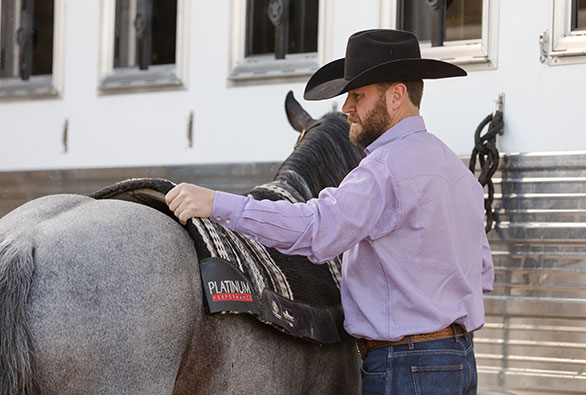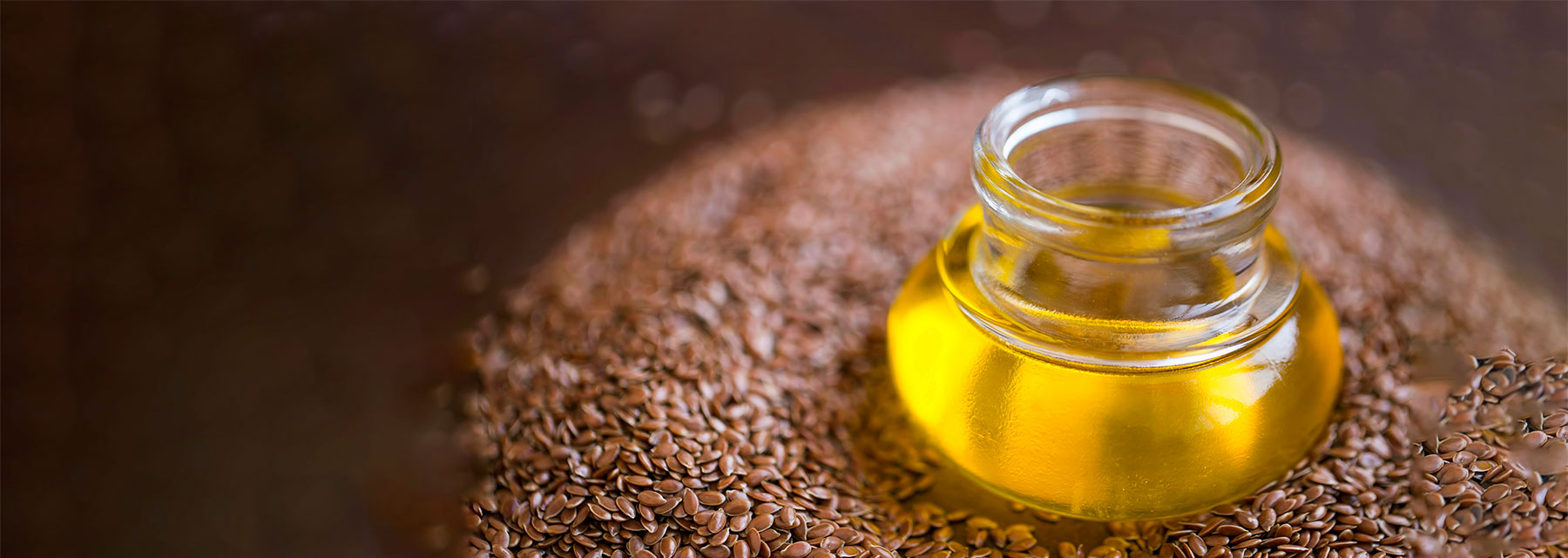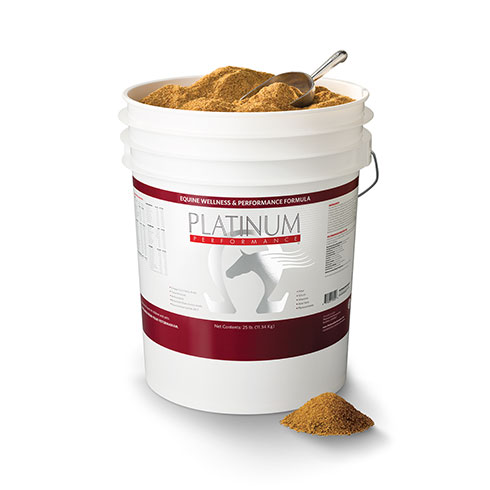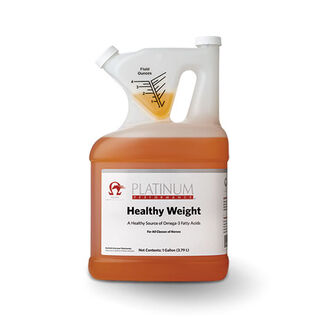The Benefits of Omega-3 Essential Fatty Acids & Your Horse
While nutrition has historically been considered the appropriate amount of nutrients needed for energy, to maintain weight and promote growth, the majority of dietary effects may actually occur in ways that are, in fact, not always obvious to the naked eye, until there is evidence of a health concern. But what is consumed through the daily diet really begins by influencing at the level of the cell and has a profound effect on each and every living animal. What the horse consumes has the ability to benefit so many areas of health, including immunity, athletic performance, reproduction, metabolism, longevity and more. But what the horse takes in daily also has the ability to interfere or take away from the health and well-being of the animal. A specific fat, the omega-3 fatty acid, has a significant role in equine nutrition due in no small part to its multiple applications on numerous health areas. The use of supplementary omega-3 fats in equine diets has given pause to many horse owners when it comes to feeding their horses, preempting justified questions, such as: What are they? Are they necessary? How do they benefit the horse?
Fat & the Equine Diet
Fat represents a relatively small amount of the natural diet, as fresh grasses contain approximately 4 percent or less total fat. However, it is still a necessary nutrient in the daily diet as it is an important structural component for cells and can be an important dietary source of fuel for the horse. Dietary fats are biologically needed to provide structure to cell membranes and act as a precursor or integral part of many hormones, including cortisol, prostaglandins and other eicosanoids. They also serve as a carrier for fat-soluble nutrients, such as vitamins A, D, E and K, and other antioxidants found in plants. Fats are often used to enhance overall body condition as they are an excellent source of calories, supplying over twice the number of calories than that of comparable units of protein or carbohydrates. Feeding supplementary fat sources in the diet can offer a wide array of benefits, particularly for the equine athlete. Fats can delay the onset of fatigue and can be used as a preferential muscle fuel, especially important for carbohydrate-sensitive horses that require low starch and sugar intake as they limit anaerobic carbohydrate metabolism during exercise, resulting in less lactic acid production and better muscle glycogen utilization. Fats reduce circulating cortisol levels associated with stress and exercise. Compared to non-structural carbohydrates, the breakdown of fat yields a more moderate blood glucose and insulin response, which can provide more even energy levels and diminish behavioral excitability.
Fats can provide many health benefits. However, as with most things, some types of fats are better than others. Depending on their chemical makeup, fats are categorized as either saturated or unsaturated. Unsaturated fats are further split into monounsaturated and polyunsaturated subcategories. Fatty acids, the constituents of the fat macronutrient, fall into one of these three categories — saturated, monounsaturated or polyunsaturated. Fats and oils contain all three of these types of fatty acids, but what makes one fat source better than another depends on which specific type predominates or the ratio of their fatty acid profile. Most animal fats and coconut oil consist of saturated fatty acids. Natural pasture grass also contains saturated fat, at a very small amount but enough to maintain cellular structure. Additional saturated fats in the diet of the horse are not warranted. Unsaturated fats are more fragile and vulnerable to rancidity from exposure to oxygen, heat and moisture. Monounsaturated fatty acids are found in rice bran, rice bran oil and, to some extent, in canola oil (also in great quantities in olive oil, nuts and avocados, though not commonly fed to horses). Monounsaturated fats belong to the omega-9 family, which is based on the chemical structure of the molecule. Polyunsaturated fatty acids (PUFA) exist in many forms. There are two that the horse is unable to produce internally and must consume in the diet, referred to as essential fatty acids — omega-3 fatty acids (α-linolenic acids, ALA) and omega-6 fatty acids (linoleic acid, LA). Both of these types of fatty acids are critical to the horse and perform a number of functions together in the body that influences brain function, vision, skin and hair growth, bone health, adrenal and sex hormone production, as well as normal growth and development. While all fatty acids are important, the ratio of these fatty acids is very influential to overall health.
While both omega-3 and omega-6 fats are necessary for the well-being of the horse, the dietary ratio is critical, and it is in their best interest to emulate the natural diet as much as possible. Supplementation with omega-3 fatty acids can help to rebalance the fatty acid profile toward that of a natural grazing diet.
The Yin & Yang of Health: Omega-6 vs. Omega-3 Fatty Acids
Essential fatty acids are a small but mighty component of the natural grazing diet of the horse. Both omega-6 and omega-3 are considered to be “essential” fatty acids (EFA) due to the fact that the horse’s body lacks the necessary enzymes for desaturation and therefore cannot manufacture them internally, so they must be ingested from the daily diet. Both necessary for overall health, the major difference between these fats pertaining to health is that omega-6 fatty acids are considered to be pro-inflammatory mediators producing eicosanoids and prostaglandins, and excessive levels of them are correlated with cellular damage, elongated healing times and several disease states. Conversely, omega-3 fatty acids help maintain normal production of cytokines, the chemicals involved in creating inflammation and a normal inflammatory response, lending themselves to many systemic attributes.
Inflammation is natural and is traditionally considered the body’s first line of defense against injury, infections and toxins. Distressed cells release chemicals to alert the immune system that help is needed. This reaction is required for acute tissue healing and rehabilitation. However, when it persists over time, the immune system is in an ongoing state of emergency. Under these circumstances, the chemical mediators of inflammation result in cellular damage, contribute to poor recovery from injuries or surgery, cause excess pain and can result in lasting damage to the tissues and major organs. In this unfortunate cycle, the cellular insult invariably results in further release of inflammatory mediators, and the extent of the damage worsens. An ongoing state of inflammation has been linked to nearly all major equine health concerns, including laminitis, obesity and insulin resistance, equine asthma and allergies, arthritis, myopathies and equine Cushing’s disease. Managing normal inflammation through the diet is a noninvasive and powerful way to promote health and long-term wellness.
As a grazing herbivore, horses have evolved on a natural foraging diet that contains a fatty acid ratio of up to five times the total amount of anti-inflammatory omega-3 fatty acids than omega-6 fats. Because of this, they are often considered “omega-3 animals,” even more so than humans and other companion animals. All the way down to the level of the cell, ingested fatty acids are incorporated into each of the trillions of cell membranes throughout the body. The composition of the cell membrane directly affects the cells’ ability to function. When greater quantities of omega-3 fats are represented, the resulting changes in membrane fluidity and integrity, as well as cell receptor signaling and protein synthesis, can alter the biological response to trauma and infection. Today, while some horses have access to fresh grass, a typical modern equine diet includes a combination of hay and cereal grains, a grain-based commercial feed or corn oil. This increase in grain-based feeds has caused a widespread inverse ratio to the natural essential fat ratio of the horse, drastically increasing the concentration of omega-6 fats in the diet and decreasing the total amount of omega-3 fats. It has been estimated that the typical diet of the horse today provides up to 18 times more omega-6 than omega-3 fatty acids, which can potentially predispose them to a multitude of health issues. While both omega-3 and omega-6 fats are necessary for the well-being of the horse, the dietary ratio is critical, and it is in their best interest to emulate the natural diet as much as possible. Supplementation with omega-3 fatty acids can help to rebalance the fatty acid profile toward that of a natural grazing diet.
Omega-6 Fatty Acids
The importance that linoleic acid has in the body should not be discounted. As a PUFA, omega-6 fats help stimulate skin and hair growth, maintain bone health, regulate metabolism and maintain the reproductive system, along with many more actions in conjunction with α-linolenic acids. For horses, forage often contains an adequate concentration of omega-6 fatty acids and supplementation is rarely required. Common feeding practices typically include ingredients with high levels of omega-6 fatty acids. Cereal grains like corn, oats and barley provide huge levels of omega-6 fatty acids. Oils, such as corn oil or wheat germ oil, that are very commonly used to promote weight gain and shiny coats need to be taken into consideration as they are also capable of providing large amounts of omega-6 fats. Particularly when being used for weight gain, corn oil may actually be working against the desired outcome as it contains approximately 55 times the amount of omega-6 fatty acids to omega-3 fatty acids, potentially creating inflammation in the digestive tract that may limit feed efficiency. Soybean oil, often labeled as vegetable oil, is the most commonly added oil to commercial feeds. While it does contain some amounts of omega-3 fatty acids, unfortunately, soybean oil is very high in omega-6 fatty acids with approximately 50 percent coming from linoleic acid.
Omega-3 Fatty Acids
Omega-3 essential fatty acids can be divided into three known subcategories involved in equine physiology: the short-chain α-linolenic acid, found in plants and plant oils, and long-chain eicosapentaenoic acid (EPA) and docosahexaenoic acid (DHA), both commonly found in marine algae, phytoplankton and algal oils. Interestingly, though conversion rate is not efficient, horses do have the capability to convert ALA to form EPA and DHA. Although EPA and DHA are excellent sources of omega-3 fatty acids, supplementary products can have poor palatability. As is often the case, it is difficult to outwit Mother Nature, and plant-based omega-3 fatty acid sources seem to be a natural fit for horses. By far, ALA is the most commonly found omega-3 fatty acid in nature in the form of plant foods and is the only form of omega-3 present in the horse’s natural diet.
Fresh grass, alfalfa and clover are natural, outstanding sources of omega-3 fats with a naturally occurring ratio of 4:1 to 5:1 of omega-3 to omega-6 fatty acids. In hay, however, the level of fatty acids plummets. When grass is cut, dried and stored, most of the fragile fatty acids are quickly oxidized and destroyed. Flaxseed (also known as linseed) has an omega-3 to omega-6 fatty acid profile of about 4:1, making it an ideal ingredient to replace omega-3 losses in hay, to balance a diet containing grains or concentrates or to use simply to support general health. Ground, stabilized flaxseed meal or cold-pressed flax oil is an excellent source for supplementary omega-3 fatty acids in the form of ALA. To note, supplementary omega-3 fats should be given on a daily basis for horses to receive the full health benefits.
The Omega-3 Effect: 10 Health Areas Directly Impacted from Supplementation
Fundamental needs for omega-3 fats are met with consistent consumption of pasture. However, when fed in addition to basic needs, there is potential for widespread biological influence in many different health realms. This is due to several factors. The most important and most well-researched is omega-3 fatty acids help maintain normal levels of inflammation in the body. This is the main reason that these specialized fats are able to affect so many different areas of the body. For example, by supporting a healthy inflammatory response, omega-3 fatty acids provide nutritional support for horses with sensitive skin or seasonal allergies , It can seem complicated in its simplicity but feeding omega-3 fats can truly have a multi-systemic impact.

Tell Me More: Flax FAQs
by Emily Smith, MS Equine Nutrition Platinum Performance®
What’s So Great About Flaxseed?
Flaxseed is an excellent source of alpha linolenic acid (ALA), which is the most prevalent omega-3 fatty acid in plant food. ALA naturally exists in fresh pasture grass; however, it is quickly depleted in hay. Horses that consume a hay-based diet will consume significantly less omega-3 fatty acids than horses that have consistent access to quality pasture grasses due to the rapid decline in the concentration of omega-3 fatty acids that occurs after hay has been cut, cured and baled. Supplementation with additional omega-3 fatty acids, like ALA found in flaxseed, provides a wide spectrum of health benefits and typically results in a sleek coat and healthy skin.
Veterinarians often recommend omega-3 fatty acid supplementation to maintain overall health. Flax-based omega-3 supplementation has been shown to effectively increase cell membrane content of omega-3 fatty acids when compared to non-supplemented horses. Omega-3 fatty acids impact each cell membrane by increasing membrane fluidity. This enhances cell-to-cell communication, cell receptor function and controls the transport of compounds into and out of the cell. Benefits attributed to supplements containing flax has been seen in both horses and dogs.
Omega-3 Fatty Acids Found in Flaxseed Support:
- Hair and coat health
- Joints and soft tissues
- The balance of the immune system
- Circulation and vascular health
- Normal gastrointestinal function
- Healthy reproductive function
- Normal hoof growth
Should I Use Whole or Ground Flax?
The form of flaxseeds used as feed is important in order to reap the health benefits. Omega-3 fatty acids are rather fragile and react quickly to oxygen in the air and will oxidize, then go rancid. When the fats become rancid and denatured, you lose the health benefits.
Though not harmful, whole flaxseeds are not recommended to be fed as an omega-3 fatty acid source because they will pass through the digestive tract with the outer hull intact, defeating the purpose of using them as a source of omega-3 fats. Rather, the recommended form is grinding flaxseeds to expose the seed portion that holds the health benefits. However, freshly ground flaxseed should be fed immediately to prevent oxidation and rancidity. Because of this, it is recommended to supplement with an omega-3 formula that is stabilized with natural antioxidants to protect against oxidation and sealed airtight to ensure freshness and extend the shelf life. Flax oil is also delicate and quality products are cold-pressed to avoid high-heat processing and ensure the omega-3 fatty acids remain intact.
How Do I Use Flaxseed Oil?
Flaxseed oil is a versatile source of omega-3 fatty acids. As oils contain more calories than most feeds per comparable unit, flax oil can be used as a healthy source of calories for horses needing to gain weight. At lower quantities, flax oil can offer the same benefits as flaxseed meal due to its high levels of ALA. Flax oil is an ideal alternative to oils that contain higher levels of omega-6 fatty acids, such as the commonly used corn oil, which contains 50 times the amount of pro-inflammatory omega-6 fatty acids compared to omega-3 fatty acids. Flaxseed oil should smell nearly odorless and should be unrefined to retain the natural compounds and properties for health benefits. Cold pressing from a whole seed protects the oil from rancidity and damage caused by heat. Additionally, blending antioxidants, like natural vitamin E, into flaxseed oil acts as a natural protectant against rancidity.
10 Health Areas Directly Impacted from Omega-3 Fatty Acid Supplementation

1. Wellness
It has been shown exhaustively across species that omega-3 fats are required for cellular health and functioning. Omega-3 fatty acids provide unparalleled support for health as they incorporate into every cell membrane of the horse's body. They improve cell membrane integrity and function, and provide a ripple effect of benefits internally. Omega-3 fatty acids work hand in hand with antioxidants. Fats are needed to absorb and process many of the fat-soluble antioxidants, and in turn, antioxidants offer biological protection in the prevention of oxidation and rancidity of fats. The natural equine diet has similar attributes relying on a foundation of omega-3 fats and antioxidative nutrients to promote wellness from within.

2. Skin & Coat
Although the natural diet of the horse is relatively low in fat, a true lack of fat can be correlated to dry, brittle hair coats. Essential fatty acids are necessary for skin and coat health. A deficiency of omega-3 fats can lead to overly sensitive, itchy and inflamed skin. Shifting the ratio of essential fats more to what a horse would naturally be consuming in the wild may help to normalize inflammation in the skin and support skin health. The addition of dietary fat, such as flaxseed oil or a fatty acid supplement, can increase the amount of oil secreted by the skin’s sebaceous glands. This helps to add oiliness and sheen beneficial for dull hair coats. Not all oils are created equal, and a healthy alternative to corn oil for a shiny coat is to top-dress with cold-pressed flaxseed oil, an excellent source of omega-3 essential fatty acids.

3. Allergies
An allergy is an immune disorder characterized by hypersensitivity to specific substances called allergens that result in an excessive inflammatory response. Most commonly, allergic reactions affect the skin and respiratory airways in horses and generally develop in response to exposure to molds, spores, insect bites and certain proteins present in pasture grasses. There is a correlation between the ratio of omega-3 and omega-6 fats that horses consume and their ability to respond to an allergen. Diets that contain high concentrations of omega-6 fatty acids can exacerbate the inflammatory response. On the other hand, omega-3 fatty acids have been shown to maintain a healthy inflammatory response and provide support for seasonal skin allergies.

4. Immunity
Proper immune reactions are characterized by traditional inflammatory response. Omega-6 fatty acids and their resultant pro-inflammatory metabolites induce immunosuppressive reactions. Omega-3 fatty acids, on the contrary help maintain healthy immune responses. Excessive, ongoing inflammation or repeated, acute inflammatory responses will hinder immune function.

5. Joints & Ligaments
A common cause of joint issues in horses is persistent inflammation. With elevated inflammation, uncontrolled free radical activity and dysregulation of local enzymes can result in the degradation of critical components of cartilage, synovial fluid and the synovial membrane of the joint. Omega-3 fatty acids support a normal, healthy inflammatory response in the body. In joints, omega-3 fatty acids can help maintain healthy cartilage and normal connective tissue.

6. Digestion & Weight
The addition of healthy fats to the diet helps maintain normal inflammation in the intestine, which supports nutrient absorption. A feeding trial at the University of California, Davis, disproved the common misconception that feeding higher amounts of grain is the best or only way to add weight. In the trial, horses were fed a hay diet and administered a comprehensive omega-3 fatty acid supplement in place of feeds of the same caloric value and 88 percent of the horses gained weight in the study. Fats, even healthy ones, do contain higher calories. But the amount needed to provide the maximum benefits for omega-3 fats is a minimal caloric provision to the entire diet and can be done even to overweight horses to provide omega-3 fat benefits.

7. Hoof
Fats play a pivotal role in a healthy hoof because they retain the natural moisture and pliability of the hoof wall, resist the absorption of water from the environment and prevent bacteria and fungi from entering the hoof horn. Hoof tissue has 3 to 6 percent total fat, which works to bind cells together and aids in repelling water. Fatty acids are important nutrients for healthy hooves as they help in connecting hoof horn cells and sustain a permeability barrier. Deficiency of fat can be seen in skin and hoof problems, which is a reason many horses with dry, splitting feet that do not respond well to other vitamin/mineral-specific supplements improve when supplemented with omega-3 fatty acids.

8. Reproduction
The quality of a stallion’s semen plays a major role in fertility and depends on the dietary intake and incorporation of omega-3 fatty acids, particularly DHA, into the sperm plasma membrane as semen consists of significant amounts of fatty acids. Increasing dietary omega-3 fatty acids has been shown to support reproduction function in stallions.
Improved reproductive parameters have also been identified in mares. Omega-3 fatty acids maintain normal inflammation in the uterus and supplementation has may help maintain normal uterine health. Supplementation has been shown to support colostrum quality and maintain passive transfer of antibodies to foals.

9. Muscle
While the ideal diet for the equine athlete is high-quality forage, many horses are unable to obtain adequate energy from hay or pasture alone and are often supplemented with calorie-dense grains and oils. When compared to a high grain diet, a high fat diet that includes omega-3 fatty acids may support energy production on a cellular level. Other benefits of higher-fat diets include supporting normal lactate production during exercise and promoting normal glucose metabolism, which could enhance exercise tolerance and support normal muscle recovery after exercise.

10. Metabolic
Omega-3 fatty acids have been shown to help maintain blood glucose levels within normal ranges by supporting metabolism and glucose uptake by cells. To determine the benefits of a comprehensive omega-3 supplement with the addition of magnesium and chromium on metabolic parameters associated with insulin resistance or equine metabolic syndrome, researchers at Colorado State University measured insulin and glucose responses of horses. Following 6 to 8 months of supplementation, borderline insulin-resistant horses had a 19 to 20 percent decrease in fasting cortisol (p < 0.05) and insulin (p = 0.052), as reported from the study. This correlated to a significant 15 percent improvement in the average RISQI score (an index of insulin resistance), reclassifying these horses from borderline insulin resistant to normal in this study.
Omega-3 fatty acids provide unparalleled support for equine health as they incorporate into every cell membrane of the horse’s body and improve numerous cellular functions.
All the Ways: Omega-3 Fats for Daily Wellness & “What Ails You”
Whether simply used for a dazzling, dappled coat or as support for health and performance, omega-3 fatty acids have been time-tested and shown through research to offer big health benefits when fed daily. As exciting as the research has been in horses, the studies in human medicine are equally as fascinating and delve into the omega-3 fat effect on the deepest areas of health. Across species, omega-3 fatty acids support a number of health areas.
Supplementing horses with omega-3 fatty acids can help to rebalance the commonly off-tilt ratio of omega-3 to omega-6 fatty acids toward that of a natural grazing diet. Including these fats in the diet even to a horse with constant access to fresh grass will only further support a healthy ratio. Supplementation can be quite critical for horses without consistent pasture, those that are on a hay-only diet or to balance the inclusion of grains, commercial feeds or heavy omega-6 vegetable oils. With sound science and research behind it, omega-3 fatty acids can help maintain everyday health in horses.
Where to Find Omega-3s
More Details and Product Analysis »See Results »
More Details »See Results »

by Emily Smith, MS,
Platinum Performance®


